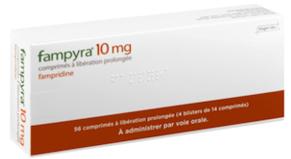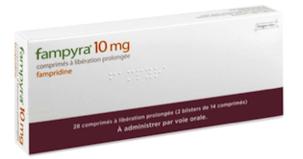|
英文药名:Fampyra(fampridine prolonged-release tablets) 中文药名:氨吡啶缓释片 生产厂家:Biogen Idec德国公司
4.5 Interaction with other medicinal products and other forms of interaction Interaction studies have only been performed in adults. Concurrent treatment with other medicinal products containing fampridine (4-aminopyridine) is contraindicated (see section 4.3). Fampridine is eliminated mainly via kidneys with active renal secretion accounting for about 60% (see section 5.2). OCT2 is the transporter responsible for the active secretion of fampridine. Thus, the concomitant use of fampridine with medicinal products that are inhibitors of OCT2 for example, cimetidine are contraindicated (see section 4.3) and concomitant use of fampridine with medicinal products that are substrates of OCT2 for example, carvedilol, propanolol and metformin is cautioned (see section 4.4.) Interferon: fampridine has been administered concomitantly with interferon-beta and no pharmacokinetic medicinal product interactions were observed. Baclofen: fampridine has been administered concomitantly with baclofen and no pharmacokinetic medicinal product interactions were observed. 4.6 Fertility, pregnancy and lactation Pregnancy There are no data from the use of fampridine in pregnant women. Animal studies have shown reproductive toxicity (see section 5.3). As a precautionary measure it is preferable to avoid the use of Fampyra in pregnancy. Breast-feeding It is unknown whether fampridine is excreted in human or animal milk. Fampyra is not recommended during breast-feeding. Fertility In animal studies no effects on fertility were seen. 4.7 Effects on ability to drive and use machines Fampyra has moderate influence on the ability to drive and use machines because Fampyra can cause dizziness. 4.8 Undesirable effects The safety of Fampyra has been evaluated in randomised controlled clinical studies, in open label long term studies and in the post marketing setting. Adverse reactions identified are mostly neurological and include seizure, insomnia, anxiety, balance disorder, dizziness, paraesthesia, tremor, headache and asthenia. This is consistent with fampridine's pharmacological activity. The highest incidence of adverse reactions identified from placebo-controlled trials in multiple sclerosis patients with Fampyra given at the recommended dose, are reported as urinary tract infection (in approximately 12% of patients). Adverse reactions are presented below by system organ class and absolute frequency. Frequencies are defined as: very common (≥ 1/10); common (≥ 1/100 to < 1/10); uncommon (≥1/1,000 to <1/100); rare (≥1/10,000 to <1/1,000); very rare (<1/10,000); not known (cannot be estimated from the available data). Within each frequency grouping, adverse reactions are presented in the order of decreasing seriousness
Description of selected adverse reactions Seizure In post-marketing experience, there have been reports of seizure, the frequency is not known (cannot be estimated from the available data). For further information on seizure risk, please refer to sections 4.3 and 4.4. Hypersensitivity In post-marketing experience, there have been reports of hypersensitivity reactions (including anaphylaxis) which have occurred with one or more of the following: dyspnoea, chest discomfort, hypotension, angioedema, rash and urticaria. For further information on hypersensitivity reactions, please refer to sections 4.3 and 4.4. Reporting of suspected adverse reactions Reporting suspected adverse reactions after authorisation of the medicinal product is important. It allows continued monitoring of the benefit/risk balance of the medicinal product. Healthcare professionals are asked to report any suspected adverse reactions via the national reporting system: Ireland HPRA Pharmacovigilance, Earlsfort Terrace, IRL - Dublin 2 Tel: +353 1 6764971 Fax: +353 1 6762517 Website: www.hpra.ie e-mail: medsafety@hpra.ie United Kingdom Yellow Card Scheme Website: www.mhra.gov.uk/yellowcard 4.9 Overdose Symptoms Acute symptoms of overdose with Fampyra were consistent with central nervous system excitation and included confusion, tremulousness, diaphoresis, seizure, and amnesia. Central nervous system side effects at high doses of 4-aminopyridine include confusion, seizures, status epilepticus, involuntary and choreoathetoid movements. Other side effects at high doses include cases of cardiac arrhythmias (for example, supraventricular tachycardia and bradycardia) and ventricular tachycardia as a consequence of potential QT prolongation. Reports of hypertension have also been received. Management Patients who overdose should be provided supportive care. Repeated seizure activity should be treated with benzodiazepine, phenytoin, or other appropriate acute anti-seizure therapy. 5. Pharmacological properties 5.1 Pharmacodynamic properties Pharmacotherapeutic group: Other nervous system drugs, ATC code: N07XX07. Pharmacodynamic effects Fampyra is a potassium channel blocker. By blocking potassium channels, Fampyra reduces the leakage of ionic current through these channels, thereby prolonging repolarization and thus enhancing action potential formation in demyelinated axons and neurological function. Presumably, by enhancing action potential formation, more impulses might be conducted in the central nervous system. Clinical efficacy and safety Two phase III, randomized, double-blind, placebo controlled confirmatory studies, (MS-F203 and MS-F204) have been performed. The majority of patients in these studies were using immunomodulatory medicines. The Fampyra dose was 10mg BID. The primary endpoint was the responder rate in walking speed as measured by the Timed 25-foot Walk (T25FW). A responder was defined as a patient who consistently had a faster walking speed for at least three visits out of a possible four during the double blind period as compared to the maximum value among five non-double blind off-treatment visits. A significantly greater proportion of patients taking Fampyra 10 mg BID were responders as compared to placebo (MS-F203: 34.8% vs. 8.3%, p<0.001; MS-F204: 42.9% vs. 9.3%, p<0.001). Patients who responded to Fampyra increased their walking speed on average by 26.3% vs 5.3% on placebo (p<0.001) (MS-F203) and 25.3% vs 7.8% (p< 0.001) (MS-F204). The improvement appeared rapidly (within weeks) after starting Fampyra. Statistically and clinically meaningful improvements in walking were seen, as measured by the 12- item Multiple Sclerosis Walking Scale. Pivotal Studies MS-F203 and MS-F204
The medicinal product has been authorised under a so-called "conditional approval" scheme. This means that further evidence on this medicinal product is awaited, in particular about Fampyra's benefits beyond its effects on walking speed and with respect to early identification of responders. A study will be conducted to investigate this. The European Medicines Agency will review new information on this medicinal product at least every year and this SmPC will be updated as necessary. 5.2 Pharmacokinetic properties Absorption: Orally administered fampridine is rapidly and completely absorbed from the gastrointestinal tract. Fampridine has a narrow therapeutic index. Absolute bioavailability of Fampyra prolonged-release tablets has not been assessed, but relative bioavailability (as compared to an aqueous oral solution) is 95%. The Fampyra prolonged-release tablet has a delay in the absorption of fampridine manifested by slower rise to a lower peak concentration, without any effect on the extent of absorption. When Fampyra tablets are taken with food, the reduction in the area under the plasma concentration-time curve (AUC0-∞) of fampridine is approximately 2-7% (10 mg dose). The small reduction in AUC is not expected to cause a reduction in the therapeutic efficacy. However, Cmax increases by 15-23%. Since there is a clear relationship between Cmax and dose related adverse reactions, it is recommended to take Fampyra without food (see section 4.2). Distribution: Fampridine is a lipid-soluble medicinal product which readily crosses the blood-brain barrier. Fampridine is largely unbound to plasma proteins (bound fraction varied between 3-7% in human plasma). Fampridine has a volume of distribution of approximately 2.6 l/kg. Fampridine is not a substrate for P-glycoprotein. Biotransformation: Fampridine is metabolised in humans by oxidation to 3-hydroxy-4-aminopyridine and further conjugated to the 3-hydroxy-4-aminopyridine sulfate. No pharmacological activity was found for the fampridine metabolites against selected potassium channels in vitro. The 3-hydroxylation of fampridine to 3-hydroxy-4-aminopyridine by human liver microsomes appeared to be catalyzed by Cytochrome P450 2E1 (CYP2E1). There was evidence of direct inhibition of CYP2E1 by fampridine at 30 μM (approximately 12% inhibition) which is approximately 100 times the average plasma fampridine concentration measured for the 10 mg tablet. Treatment of cultured human hepatocytes with fampridine had little or no effect on induction of CYP1A2, CYP2B6, CYP2C9, CYP2C19, CYP2E1 or CYP3A4/5 enzyme activities. Elimination: The major route of elimination for fampridine is renal excretion, with approximately 90% of the dose recovered in urine as parent medicinal product within 24 hours. Renal clearance (CLR 370 ml/min) is substantially greater than glomerular filtration rate due to combined glomerular filtration and active excretion by the renal OCT2 transporter. Faecal excretion accounts for less than 1% of the administered dose. Fampyra is characterized by linear (dose-proportional) pharmacokinetics with a terminal elimination half-life of approximately 6 hours. The maximum plasma concentration (Cmax) and, to a smaller extent, area under the plasma concentration-time curve (AUC) increase proportionately with dose. There is no evidence of clinically relevant accumulation of fampridine taken at the recommended dose in patients with full renal function. In patients with renal impairment accumulation occurs relative to the degree of impairment. Special Populations Older people: Clinical studies of Fampyra did not include sufficient numbers of subjects aged 65 and over to determine whether they respond differently from younger patients. Fampyra is primarily excreted unchanged by the kidneys, and with creatinine clearance known to decrease with age, monitoring of renal function in older patients should be considered (see section 4.2). Paediatric Population: No data are available. Patients with renal impairment: Fampridine is eliminated primarily by the kidneys as unchanged medicinal product and therefore renal function should be checked in patients where renal function might be compromised. Patients with mild renal impairment can be expected to have approximately 1.7 to 1.9 times the fampridine concentrations achieved by patients with normal renal function. Fampyra must not be administered to patients with mild, moderate and severe renal impairment (see section 4.3). 5.3 Preclinical safety data Fampridine was studied in oral repeat dose toxicity studies in several animal species. Adverse responses to orally administered fampridine were rapid in onset, most often occurring within the first 2 hours post-dose. Clinical signs evident after large single doses or repeated lower doses were similar in all species studied and included tremors, convulsions, ataxia, dyspnoea, dilated pupils, prostration, abnormal vocalization, increased respiration, and excess salivation. Gait abnormalities and hyper-excitability were also observed. These clinical signs were not unexpected and represent exaggerated pharmacology of fampridine. In addition, single cases of fatal urinary tract obstructions were observed in rats. The clinical relevance of these findings remains to be elucidated, but a causal relationship with fampridine treatment cannot be excluded. In reproduction toxicity studies in rats and rabbits, decreased weight and viability of foetuses and offspring were observed at maternally toxic doses. However, no increased risk for malformations or adverse effects on fertility were noted. In a battery of in vitro and in vivo studies fampridine did not show any potential to be mutagenic, clastogenic or carcinogenic. 6. Pharmaceutical particulars 6.1 List of excipients Tablet core: Hypromellose Microcrystalline cellulose Silica, colloidal anhydrous Magnesium stearate Film-coat: Hypromellose Titanium dioxide (E-171) Polyethylene glycol 400 6.2 Incompatibilities Not applicable. 6.3 Shelf life 3 years. After first opening a bottle, use within 7 days. 6.4 Special precautions for storage Store below 25°C. Store the tablets in the original packaging in order to protect from light and moisture. 6.5 Nature and contents of container Fampyra is supplied in either bottles or blister packs. Bottles HDPE (high-density polyethylene) bottle with polypropylene caps, each bottle contains 14 tablets and a silica gel desiccant. Pack size of 28 (2 bottles of 14) tablets. Pack size of 56 (4 bottles of 14) tablets. Blister packs Foil blisters (aluminium / aluminium), each blister tray contains 14 tablets. Pack size of 28 (2 blisters of 14) tablets. Pack size of 56 (4 blisters of 14) tablets. Not all pack sizes may be marketed. 6.6 Special precautions for disposal and other handling No special requirements. 7. Marketing authorisation holder Biogen Idec Limited Innovation House 70 Norden Road Maidenhead Berkshire SL6 4AY United Kingdom 8. Marketing authorisation number(s) EU/1/11/699/001 EU/1/11/699/002 EU/1/11/699/003 EU/1/11/699/004 9. Date of first authorisation/renewal of the authorisation Date of first authorisation: 20 July 2011 Date of latest renewal: 3 July 2015 10. Date of revision of the text July 2015 Detailed information on this medicine is available on the European Medicines Agency website: http://www.ema.europa.eu | |||||||||||||||||||||||||||||||||||||||||||||||||||||||||||||||||||||||||||||||||||||||||||||||||||||||||||||||||||||||||||||||||||||||||||||||||||||||||||||||||||||||||||||||||||||||||||||||||||||||||||||||||||||||||||||||||||||||||||||||||||||||||||
Fampyra(fampridine prolonged-release tablets)简介:
英文药名:Fampyra(fampridine prolonged-release tablets)
中文药名:氨吡啶缓释片
生产厂家:Biogen Idec德国公司给药说明中文通用名:氨吡啶英文商品名:FAMPYRA英文通用名:FAMPRIDINE活性物质: ... 责任编辑:admin |
最新文章更多推荐文章更多热点文章更多
|



